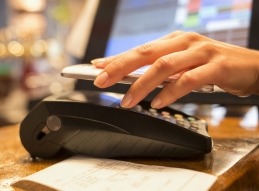HOW APPLE PAY IS CHANGING RETAIL PAYMENTS
Apple Pay is a mobile payment service that allows consumers to use supported Apple mobile devices as a means to make payments at retail and online checkouts. The concept, as defined by Apple, intends to digitize and replace “outdated and vulnerable” magnetic stripe card transactions that take place regularly at credit card terminals. Larger financial institutions including Chase, Citi, Bank of America, Wells Fargo, Capital One, and American Express have signed on to support Apple Pay. It is likely that in the very near future most credit card issuers will support it.
Proponents of the technology say that the service keeps customer payment information private from the retailer, and generates a dynamic security code for each transaction.
To use Apple Pay at brick and mortar stores, users hover their authenticated Apple over the payment terminal. When the consumer is ready to complete an in-store payment, they select the desired payment account in their Apple Pay application, hold their finger on the TouchID sensor, and wave or tap the phone against the merchant’s NFC reader. If you already have an NFC reader, a separate device is not necessary.

How does Apple Pay affect equipment dealers?
Since Apple Pay is simply another way consumers can use their credit and debit cards, nothing much will change for you, the merchant. The payment is still processed by your existing electronic payment processor and appears on your monthly statement just like any other Visa, MasterCard, or American Express payment. (Discover Card is not supported) There are no additional processing fees to accept payments made through Apple Pay.
Essentially, the transaction works the same way it would if you had swiped the card using the magnetic stripe reader (except without the actual swipe). Because Apple Pay takes advantage of payment tokenization developed by the card brands specifically for use with NFC readers, it is a highly secure form of payment. The cardholder’s actual account number is never transmitted, and the token can only be used for a one-time purchase.
How it works in an eCommerce environment
A merchant who accepts Apple Pay in an eCommerce website or for in-app purchases must submit a certificate signing request (CSR) to Apple. Apple uses that CSR to generate a unique private encryption key that is downloaded and stored by the merchant’s payment processor. The transaction is then processed like any other transaction. The security of the transaction is very similar to the use of point-to-point encryption technology, since the sensitive cardholder data is encrypted before it ever leaves Apple’s cloud system. And since the cardholder is required to use Apple’s TouchID service, it would be very difficult for a fraudster to steal an iPhone and use it to make fraudulent purchases.
What do I need to do to be ready?
ChargeItPro’s payment processing solution is set up to support Apple Pay for merchants. ChargeItPro version 5 and new ChargeItPro devices accommodate Apple Pay and other NFC payments. These new units, the PAX S80 and PAX MT30, are also EMV ready. ASPEN and ChargeItPro are committed to keeping you ahead of the curve at every turn—and with every innovation.
The staff at ChargeItPro can answer any questions you may have: call 800-989-2135 or contact sales@chargeitpro.com.
Read more about how consumers will use Apple Pay in MacWorld